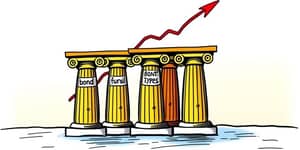In a world where financial stress touches nearly every household, understanding debt is the first step toward empowerment. This comprehensive guide unravels the complex web of personal and public liabilities, providing readers with practical repayment tactics for faster payoff and visionary policy insights. Whether you’re an individual seeking relief or a policymaker shaping national fiscal health, the path to a brighter tomorrow begins here.
Why Debt Is a Central Issue in 2025
Debt reduction has soared to the top of Americans’ financial priorities, with 42% ranking it as their number one goal—outpacing savings for major purchases and retirement. In fact, 97% of households begin the year with at least one financial objective, yet nearly 90% anticipate hurdles like excessive expenses (38%) and high debt levels (30%). These statistics highlight a collective determination to regain control, and an urgent need for effective strategies.
Globally, public debt is projected to reach almost 100% of GDP by decade’s end, surpassing pandemic-era peaks. Emerging and developing economies face ballooning debt service costs, eroding fiscal flexibility and intensifying borrowing expenses. As sovereign bond issuance climbs toward a record $17 trillion in OECD nations, transparency and risk management have never been more crucial.
The Emotional Toll of Personal Debt
Beyond numbers and percentages, debt exacts an emotional price. Over half of individuals worry about its long-term impact, and 48% fear it will derail life plans. Stress, anxiety, and a persistent sense of inadequacy accompany mounting balances, creating a feedback loop that impedes clear decision-making. Yet 84% believe that reducing debt would reduce financial stress and transform their quality of life, underscoring the power of actionable progress.
Facing debt head-on can be daunting, but knowledge and structure provide relief. By breaking the problem into manageable steps and celebrating each milestone, individuals restore confidence and cultivate healthy financial habits. This emotional shift—from fear to control—is the catalyst for sustainable change.
Individual Debt Management Strategies
Effective debt management rests on solid foundations. Begin with a comprehensive debt assessment to catalog all obligations: credit cards, student loans, auto financing, and mortgages. Document outstanding balances, interest rates, and due dates to visualize the full picture. Armed with clarity, you’re ready to allocate resources wisely.
Adopting a budgeting framework like the 50-30-20 rule—50% for needs, 30% for wants, and 20% for savings and debt repayment—provides structure and flexibility. Trimming discretionary expenses, such as dining out and streaming subscriptions, can free significant funds. Remember to revisit and adjust your budget periodically, aligning it with life changes, unexpected costs, or new income streams.
Beyond planning, tactical repayment accelerates progress. Always pay more than the minimum to reduce principal faster and minimize interest. Automate timely payments to avoid fees and credit damage. Explore options for interest rate reduction or debt consolidation, which can simplify your payment schedule and lower overall costs. Cultivating spending discipline ensures that newfound savings funnel directly to debt elimination.
For complex situations or large balances, consider professional guidance. A Certified Financial Planner (CFP®) or credit counselor can tailor strategies to your circumstances, negotiate with creditors, and offer ongoing support. Their expertise provides accountability, fresh perspectives, and often, access to solutions you might not discover alone.
Key Debt Metrics at a Glance
Government and Systemic Debt Management
On a national scale, sustainable debt requires structured frameworks. The Medium-Term Debt Management Strategy (MTDS) developed by the IMF and World Bank provides a robust blueprint. It emphasizes risk identification, diversified funding sources, policy scenario analysis, and annual reviews. By balancing cost and risk, governments safeguard fiscal buffers while addressing critical spending needs.
Transparency is another cornerstone. Clear, accessible reporting of public liabilities builds investor confidence and helps maintain manageable borrowing costs. Recent IMF directives mandate more detailed disclosures, curbing the use of opaque instruments like securitized or collateralized debt. Strengthening institutional capacity through technical assistance—over 200 IMF missions in the past two years—ensures these practices endure.
However, policymakers must also make difficult trade-offs. Reducing debt often competes with pressing social programs, infrastructure investments, and economic stimulus. Crafting policies that reform subsidies, pensions, and tax regimes can create fiscal space without undermining essential services. Engaging the public in understanding these choices fosters support and shared responsibility.
Actionable Steps for a Brighter Financial Future
Whether tackling personal balances or national budgets, progress stems from deliberate action. Below are tailored recommendations to guide diverse stakeholders.
- Assess all debts and prioritize the highest interest balances first.
- Create, track, and revise a realistic budget regularly.
- Automate payments and aim to exceed minimum dues.
- Seek professional advice for tailored solutions and accountability.
For governments and institutions, structural reforms and robust reporting are imperative.
- Implement transparent public debt reporting to maintain market trust.
- Adopt MTDS frameworks to balance cost and risk over the medium term.
- Reform fiscal programs to expand budgetary flexibility.
- Invest in capacity building and stakeholder education on debt risks.
Conclusion: Embracing Financial Mastery
Debt need not be a perpetual burden. By combining comprehensive debt assessment, disciplined budgeting, and targeted repayment tactics, individuals can reclaim control and reduce stress. At the national level, transparency, strategic frameworks, and public engagement can steer economies toward long-term stability.
The journey from indebtedness to financial freedom is both practical and emotional. Each payment, each budget adjustment, and each policy reform brings us closer to a future defined not by liabilities, but by opportunity, resilience, and growth. Embrace these strategies today, and chart your course toward a brighter, debt-free tomorrow.
References
- https://www.cfp.net/news/2024/12/reducing-debt-is-americans-no-1-financial-priority-for-2025-cfp-board-research-finds
- https://www.amerantbank.com/ofinterest/debt-management-strategies-for-financial-freedom-2025/
- https://extension.wvu.edu/youth-family/finances/blog/2025/04/01/smart-strategies-for-effective-debt-management
- https://www.worldbank.org/en/programs/debt-toolkit/mtds
- https://www.imf.org/en/Blogs/Articles/2025/06/12/disclosing-public-debt-boosts-investor-confidence-cuts-borrowing-costs
- https://www.imf.org/en/Blogs/Articles/2025/04/23/rising-global-debt-requires-countries-to-put-their-fiscal-house-in-order
- https://www.oecd.org/en/publications/2025/03/global-debt-report-2025_bab6b51e.html
- https://unctad.org/publication/world-of-debt










